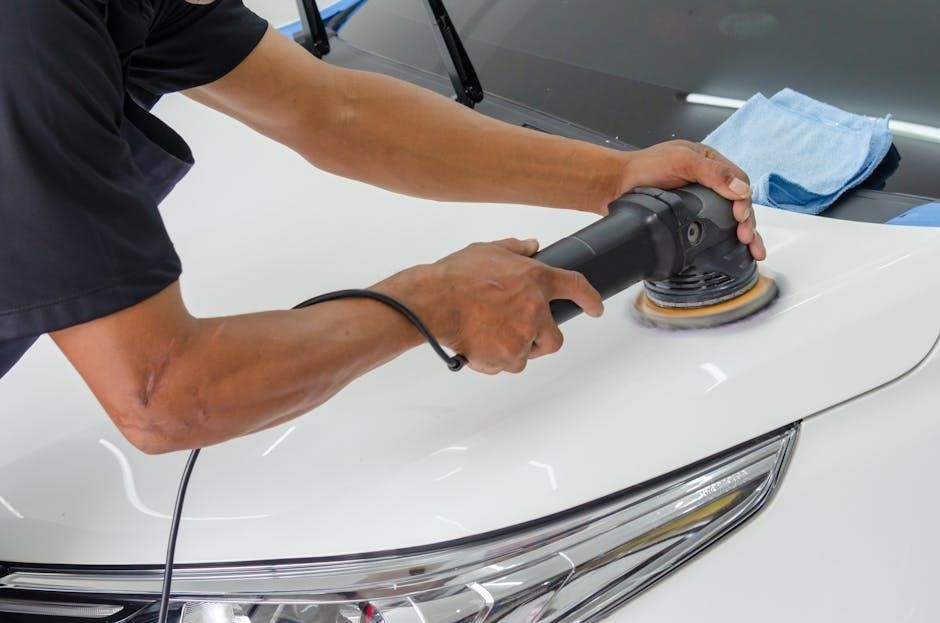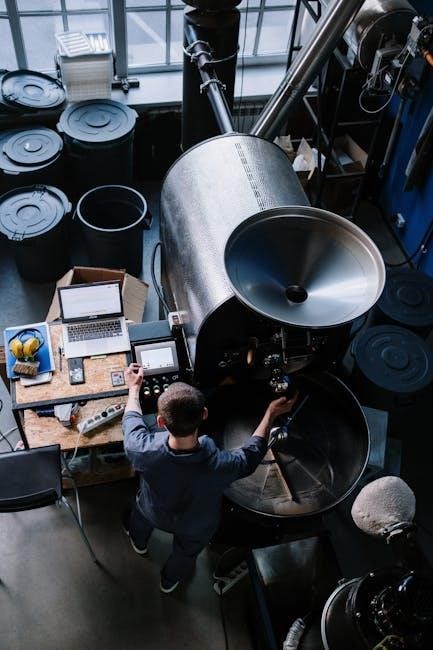gigabyte b650 gaming x ax manual
Welcome to the Gigabyte B650 Gaming X AX manual, your comprehensive guide to understanding and utilizing this high-performance motherboard. This manual provides essential information for installation, configuration, and troubleshooting, ensuring optimal use of its advanced features.
1.1 Overview of the Motherboard
The Gigabyte B650 Gaming X AX is a high-performance ATX motherboard designed for AMD Ryzen 5, 7, and 9 7th Gen processors. It features Socket AM5 compatibility, DDR5 memory support, and PCIe 4.0 technology for enhanced performance. With Wi-Fi 6E and Realtek 2.5GbE LAN, it offers robust connectivity options. The motherboard supports USB 3.2 Gen 2 and multiple storage solutions, making it ideal for gaming and high-performance computing. Its durable design and advanced cooling features ensure reliability and stability for demanding workloads. This board is tailored for users seeking a balance between power and efficiency in their PC builds.
1.2 Importance of Reading the Manual
Reading the Gigabyte B650 Gaming X AX manual is crucial for ensuring proper installation, configuration, and operation of the motherboard. It provides detailed instructions for handling sensitive components, such as the CPU and RAM, to prevent damage. The manual outlines safety precautions, compatibility checks, and troubleshooting steps to address common issues. Additionally, it guides users through BIOS updates and driver installations, which are essential for maintaining optimal performance and compatibility. By following the manual, users can avoid potential pitfalls, maximize the motherboard’s capabilities, and enjoy a seamless computing experience tailored to their needs. Proper adherence ensures reliability and longevity of the system.

Specifications of the Gigabyte B650 Gaming X AX
The Gigabyte B650 Gaming X AX supports AMD Ryzen 5000 and 7000 series processors, DDR5 memory, PCIe 4.0, and USB 3.2 Gen 2. It features Wi-Fi 6E and 2.5GbE LAN for enhanced connectivity.
2.1 Key Features and Compatibility
The Gigabyte B650 Gaming X AX is designed for optimal performance with AMD Ryzen 5, 7, and 9 7th Gen processors, offering compatibility with DDR5 memory and PCIe 4.0. It supports Wi-Fi 6E and Bluetooth for seamless wireless connectivity and features a 2.5GbE LAN for high-speed wired connections. The motherboard also includes USB 3.2 Gen 2 ports and multiple M.2 slots for storage expansion, ensuring versatility for both gaming and professional use. Its robust design and extensive connectivity options make it a reliable choice for modern PC builds. Additionally, it supports RGB lighting for customizable aesthetics.
2.2 Processor and Memory Support
The Gigabyte B650 Gaming X AX supports AMD Ryzen 5, 7, and 9 7th Gen processors, utilizing the Socket AM5 platform. It is compatible with DDR5 memory, offering dual-channel support for enhanced performance. The motherboard supports up to 128GB of RAM, with speeds reaching up to 6000MHz when overclocked. Additionally, it features compatibility with ECC memory for professional applications. The B650 Gaming X AX also supports AMD EXPO™ technology, enabling one-click memory overclocking for optimal gaming and productivity. This ensures seamless compatibility and maximum performance for both consumer and workstation environments.
2.3 Storage and Connectivity Options
The Gigabyte B650 Gaming X AX offers robust storage and connectivity features, including PCIe 4.0 support for high-speed NVMe SSDs. It features dual M.2 slots for NVMe drives and four SATA 6Gb/s ports for traditional storage. Connectivity options include USB 3.2 Gen 2×2 Type-C, USB 3.2 Gen 2, and USB 2.0 ports for versatile peripheral support. The motherboard also supports Wi-Fi 6E and Bluetooth 5.2 for wireless connectivity, along with a 2.5GbE LAN port for wired internet. Additionally, it provides HDMI and DisplayPort outputs for multi-monitor setups and is compatible with RGB lighting systems for customizable aesthetics.
Pre-Installation Preparations
Before installing the motherboard, carefully unpack and verify all components; Ensure the chassis is compatible and prepare necessary tools. Handle static-sensitive parts with care, grounding yourself to prevent damage. Always follow safety guidelines to avoid hardware damage and ensure proper installation;
3.1 Unpacking and Inventory Check
Carefully unpack the motherboard and verify all components. Ensure the package includes the motherboard, user manual, driver discs, SATA cables, and mounting screws. Check for any visible damage or defects. Handle the motherboard by the edges to prevent static discharge. Inspect the CPU socket, RAM slots, and PCIe ports for proper condition. If any items are missing or damaged, contact Gigabyte support immediately. Familiarize yourself with the components before proceeding to ensure a smooth installation process. Properly store unused items in a safe, dry place to avoid loss or damage. Always follow safety guidelines during handling.
3.2 Chassis and Hardware Compatibility
Ensure your chassis is compatible with the Gigabyte B650 Gaming X AX motherboard, which uses the ATX form factor. Verify that the chassis supports the motherboard’s dimensions and mounting holes. Check that your CPU, RAM, and storage devices are compatible with the motherboard’s specifications. The B650 Gaming X AX supports Socket AM5 processors, DDR5 memory, and PCIe 4.0 devices. Confirm that your power supply unit (PSU) meets the motherboard’s power requirements. Refer to the motherboard manual for detailed compatibility lists. Always check the chassis manual for specific installation instructions and hardware support. Ensure proper physical clearance for all components before installation.
3.3 Safety Precautions and Grounding
Always handle the motherboard by the edges to avoid damage from static electricity. Use an anti-static wrist strap or touch a grounded metal object before handling components. Ensure the chassis is properly grounded to prevent electrical shocks. Disconnect the power supply before installing or removing components. Avoid over-tightening screws, as this may damage the motherboard or chassis. Keep the work area clean and dry to prevent accidents. Never force-fit connectors or components, as this can cause permanent damage. Proper grounding and static protection are crucial to ensure the longevity and functionality of your Gigabyte B650 Gaming X AX motherboard.
Motherboard Layout and Components
The Gigabyte B650 Gaming X AX features a well-organized layout with key components like the CPU socket, memory slots, PCIe slots, and connectivity ports.
4.1 Identifying Key Components and Headers
The Gigabyte B650 Gaming X AX motherboard features a layout designed for easy navigation. Key components include the AM5 CPU socket, four DDR5 memory slots, and PCIe 4.0 slots for graphics cards and expansion cards. The motherboard also includes multiple M.2 slots for NVMe SSDs, USB 3.2 Gen 2 ports, and HDMI/DisplayPort outputs for versatile connectivity. Headers such as the 24-pin ATX power connector, front panel headers, and RGB lighting controls are clearly labeled. Identifying these components is essential for proper installation and connectivity, ensuring optimal performance and customization of your system.
4.2 Rear Panel and Internal Connectors
The rear panel of the Gigabyte B650 Gaming X AX provides a variety of ports for connectivity, including HDMI and DisplayPort for graphics output, USB 3.2 Gen 2 ports for high-speed peripherals, and a Gigabit Ethernet jack for wired networking. Additionally, it features audio jacks for 7.1-channel surround sound. Internal connectors include headers for front panel controls, fan power, and RGB lighting synchronization. These connectors are essential for connecting case fans, RGB strips, and other internal components, ensuring a seamless and customizable system build. Proper identification and use of these connectors are crucial for optimal functionality and performance.
4.3 LEDs and Onboard Buttons
The Gigabyte B650 Gaming X AX motherboard features diagnostic LEDs and convenient onboard buttons to monitor and control system status. Power, boot, and component activity LEDs provide visual feedback for troubleshooting. The onboard power button allows system activation without a front panel connection, while the reset button offers a quick way to reboot. Additionally, the CMOS reset button enables users to restore BIOS defaults. These features simplify system management and diagnostics. The RGB Fusion LED headers further enhance customization, allowing users to personalize their system’s lighting. Proper care and handling of these components ensure optimal functionality and longevity.

Installation Guide
This section provides step-by-step instructions for installing the Gigabyte B650 Gaming X AX motherboard, including unpacking, hardware compatibility checks, and essential safety precautions to ensure a smooth setup.
5.1 CPU Installation and Socket Handling
To install the CPU, gently press the socket lever down and lift it to access the socket. Handle the CPU by the edges, avoiding contact with the pins. Align the CPU’s golden triangle with the socket’s corresponding mark. Secure the CPU by lowering it into the socket and closing the lever firmly. Ensure the CPU is properly seated to avoid damage. For Socket AM5, use compatible Ryzen processors (5, 7, 9 series). Always ground yourself or use an anti-static strap to prevent static discharge. Refer to the manual for detailed diagrams and safety precautions to ensure correct installation.
5.2 Memory (RAM) Installation
To install RAM, ground yourself to prevent static discharge. Locate the DDR5 DIMM slots on the motherboard. Align the RAM module’s notches with the slot’s key. Gently push the module into the slot at a 45-degree angle until it clicks. Secure the module by pressing down firmly. For dual-channel performance, install identical RAM sticks in corresponding slots. Ensure compatibility with DDR5 memory and recommended speeds. Refer to the manual for supported configurations and speeds. Avoid touching the gold contacts to maintain optimal performance and prevent damage. Always handle RAM by the edges for safe installation.
5.3 Storage Drive Installation
To install a storage drive, ensure the system is powered off and grounded. For NVMe SSDs, remove the protective covering from the M.2 slot. Align the drive with the slot, ensuring the key matches. Gently push the drive into the slot at a 30-degree angle and secure it with the screw. For SATA drives, connect the SATA cable to the motherboard and power supply. Mount the drive in the chassis using screws. Ensure the drive is properly connected to the motherboard and power supply. Refer to the manual for specific slot configurations and optimal drive placement. Handle drives by the edges to avoid damage.
5.4 Power Supply and Front Panel Connectors
Connect the power supply unit (PSU) to the motherboard using the 24-pin ATX cable and the 8-pin EPS connector for the CPU. Ensure these connections are secure to avoid power issues. For the front panel, locate the F_PANEL header on the motherboard. Connect the power button, reset button, HDD LED, and power LED to the appropriate pins. Refer to the manual for the correct pin layout; Additionally, connect the USB ports and audio jacks from the front panel to their respective headers. Properly securing these connections ensures stable power delivery and functional front panel controls. Handle components with care to prevent static discharge.

BIOS Setup and Configuration
Access the BIOS by pressing DEL or F2 during boot. Navigate through settings using arrow keys and configure options like boot order, memory settings, and fan controls. Save changes before exiting.
6.1 Accessing the BIOS
To access the BIOS on the Gigabyte B650 Gaming X AX, restart your system and press the DEL or F2 key repeatedly during boot. Ensure timely key presses, as the boot process is rapid. Once inside the BIOS, use arrow keys to navigate through settings. Save changes by pressing F10 before exiting. For secure access, ensure you have administrative privileges. This interface allows you to configure boot order, overclocking, and system settings. Refer to the manual for detailed navigation tips. Always save changes to avoid losing configurations.
6.2 Navigating BIOS Settings
The BIOS interface on the Gigabyte B650 Gaming X AX is user-friendly, with a tab-based layout. Use arrow keys to move between tabs like MB Intelligent Tweaker, System, and Boot. Within each tab, navigate using arrow keys and adjust settings with + or -. Press F10 to save and exit; For advanced tweaks, the MB Intelligent Tweaker tab offers overclocking options. Highlight a setting and press Enter to modify it. Use F1 for help or ESC to return to the previous menu. Familiarize yourself with this interface to optimize system performance and enable features like XMP profiles or network stack settings.
6.3 Enabling Network Stack and Other Features
To enable the network stack on the Gigabyte B650 Gaming X AX, access the BIOS by pressing Delete or F2 during boot. Navigate to the Advanced tab and locate the Network Stack option. Set it to Enabled to activate Wi-Fi and Bluetooth functionalities. Additional features like RGB lighting control can be accessed through the Peripherals tab. After making changes, press F10 to save and exit. Ensure to install the latest drivers from Gigabyte’s website for optimal performance. This step is crucial for enabling wireless connectivity and other advanced motherboard features.

Software and Driver Installation
Install essential drivers and software from Gigabyte’s official website, including chipset, Wi-Fi, and RGB firmware updates, to ensure optimal performance and security for your system.
7.1 Downloading Drivers from Gigabyte’s Website
Visit the official Gigabyte website to download the latest drivers and software for your B650 Gaming X AX motherboard. Navigate to the support section, select your motherboard model, and choose the appropriate drivers for your operating system. Ensure you download the chipset, Wi-Fi, and Bluetooth drivers to enable full functionality. Additionally, check for firmware updates for RGB lighting and other components. Always verify the integrity of downloaded files and follow installation instructions carefully to maintain system stability and performance. Regular updates are crucial for compatibility and security.
7.2 Installing Chipset and Wi-Fi Drivers
After downloading the drivers from Gigabyte’s website, install the chipset driver first to ensure proper motherboard functionality. Next, install the Wi-Fi driver to enable wireless connectivity. Run the installer for each driver, following on-screen instructions. Restart your system after installation to apply changes. Ensure the drivers are up-to-date for optimal performance. If issues arise, reinstall or update drivers through the Device Manager. Properly installed drivers are crucial for network connectivity and system stability. Always verify driver compatibility with your operating system to avoid conflicts.
7.3 Updating Firmware for RGB Lighting
To enhance RGB lighting compatibility, update the firmware using the package from Gigabyte’s website. Download the latest IT5701/5702 RGB lighting controller firmware and follow the installation instructions. This update resolves issues with third-party RGB devices like Corsair, Cooler Master, and others. After installing, restart your system to apply changes. Ensure your firmware is up-to-date for optimal RGB performance and compatibility. Regular updates help maintain functionality and aesthetics, addressing potential bugs or incompatibilities. This step is crucial for seamless integration of RGB components with your Gigabyte B650 Gaming X AX motherboard.

Wireless Connectivity Setup
Configure wireless connectivity by enabling Wi-Fi and Bluetooth in the BIOS. Download the latest drivers from Gigabyte’s support website for optimal performance. Troubleshoot network issues if connectivity fails.
8.1 Enabling Wi-Fi and Bluetooth
To enable Wi-Fi and Bluetooth on the Gigabyte B650 Gaming X AX, enter the BIOS settings by pressing Delete, F2, or Esc during startup. Navigate to the Advanced or Peripherals section and locate the Network Stack option. Enable it to activate wireless connectivity. Save changes and exit the BIOS. After restarting, download the latest Wi-Fi and Bluetooth drivers from Gigabyte’s official website. Install these drivers to ensure proper functionality. Refer to the manual for specific instructions tailored to your motherboard model.
8.2 Troubleshooting Network Issues
If you encounter network issues with the Gigabyte B650 Gaming X AX, start by ensuring the Network Stack is enabled in the BIOS. Restart your system and check for driver updates on Gigabyte’s website. Install the latest Wi-Fi and Bluetooth drivers to resolve connectivity problems. If issues persist, reset the BIOS to default settings or perform a firmware update. Additionally, verify that antennas are securely connected and that your operating system recognizes the wireless adapter. For persistent problems, contact Gigabyte support for further assistance. Always refer to the manual for detailed troubleshooting steps.

BIOS Updates and Fixes
Regular BIOS updates ensure optimal performance and compatibility with your Gigabyte B650 Gaming X AX. Check the current version in the BIOS and update it for improved functionality.
9.1 Checking Current BIOS Version
To check the current BIOS version on your Gigabyte B650 Gaming X AX, restart your PC and enter the BIOS settings by pressing F2 or DEL. Navigate to the MAIN tab, where the BIOS version is displayed. This ensures you’re running the latest firmware. Regularly updating the BIOS improves system compatibility and performance. Always download updates from Gigabyte’s official website to avoid security risks. If an update is available, follow the on-screen instructions carefully to install it. Proper installation ensures stability and prevents potential system issues. Keeping your BIOS up-to-date is crucial for optimal functionality.
9.2 Updating BIOS for Compatibility
Updating the BIOS on your Gigabyte B650 Gaming X AX is essential for ensuring compatibility with the latest hardware and features. To update, download the latest BIOS version from Gigabyte’s official website. Save the update file to a USB drive and use the Q-Flash Plus feature to apply the update without installing the CPU or memory. Follow the on-screen instructions carefully to avoid errors. Updating the BIOS can resolve compatibility issues with AMD processors and improve system performance. Always ensure a stable power supply during the update process to prevent any potential damage or data loss.
9.3 Resolving Incompatibility Issues
If you encounter compatibility issues with your Gigabyte B650 Gaming X AX, start by checking the BIOS version. Update the BIOS to the latest version to resolve potential incompatibilities with AMD processors or RAM. Ensure the network stack is enabled in the BIOS settings, as it may be disabled by default. Download and install the latest Wi-Fi and Bluetooth drivers from Gigabyte’s website. Additionally, update the AMD AGESA to version 1.2.0.3a and the chipset driver to 7.01.08.129 or later for improved compatibility and performance. Regular firmware updates for RGB lighting can also address hardware compatibility concerns.

Maintenance and Support
Regularly clean the motherboard to prevent dust buildup and ensure optimal performance. Contact Gigabyte support for assistance with troubleshooting or technical inquiries. Visit their website for updates.
10.1 Regular Maintenance Tips
To maintain your Gigabyte B650 Gaming X AX motherboard’s performance, regularly clean dust from the PCB and heatsinks using compressed air. Ensure all fans and cooling systems are functioning properly. Check for firmware updates and install the latest BIOS version to enhance compatibility and stability. Inspect internal connectors and cables for secure connections. Store the motherboard in an anti-static bag when not in use to prevent damage. For optimal operation, follow these maintenance routines to extend the lifespan of your motherboard. Visit Gigabyte’s support website for detailed care instructions and troubleshooting guides.
10.2 Contacting Gigabyte Support
For technical assistance or inquiries about your Gigabyte B650 Gaming X AX motherboard, visit the official Gigabyte website. Navigate to the “Support” section to access contact information, including email, live chat, and regional office details. Provide your motherboard model (B650 Gaming X AX) and serial number for efficient support. You can also download drivers, manuals, and firmware updates directly from their website. Gigabyte’s customer service team is available to address compatibility issues, troubleshooting, and maintenance tips, ensuring your motherboard operates at its best.























































